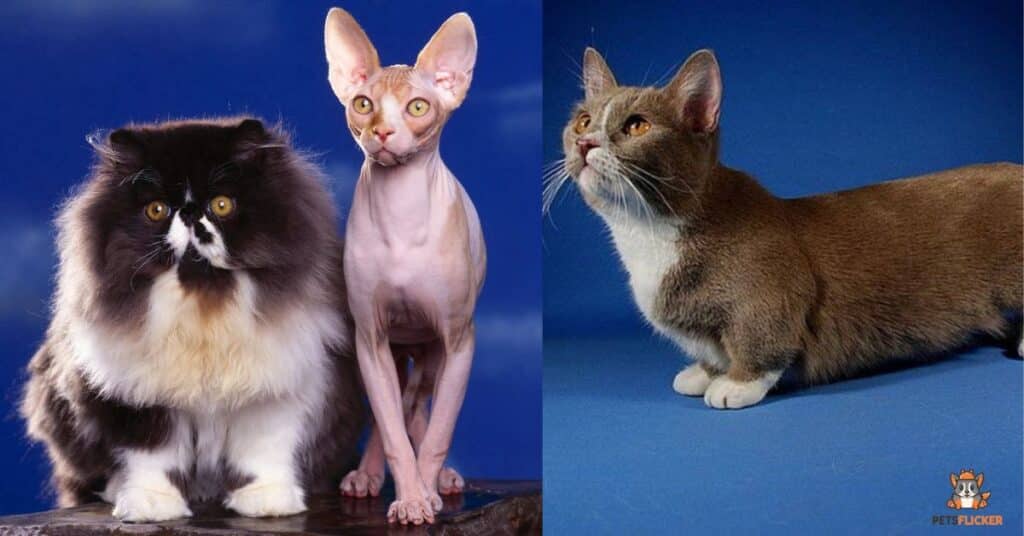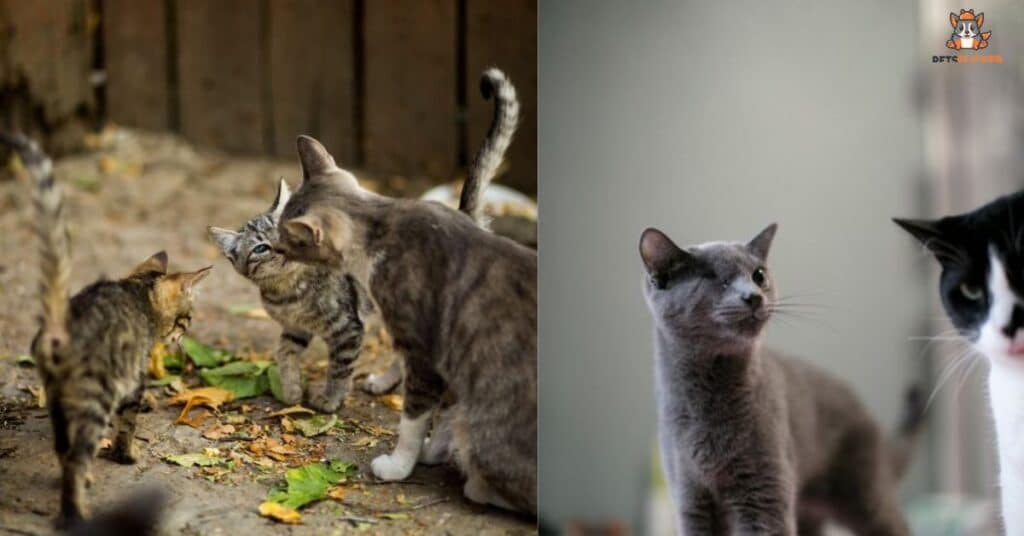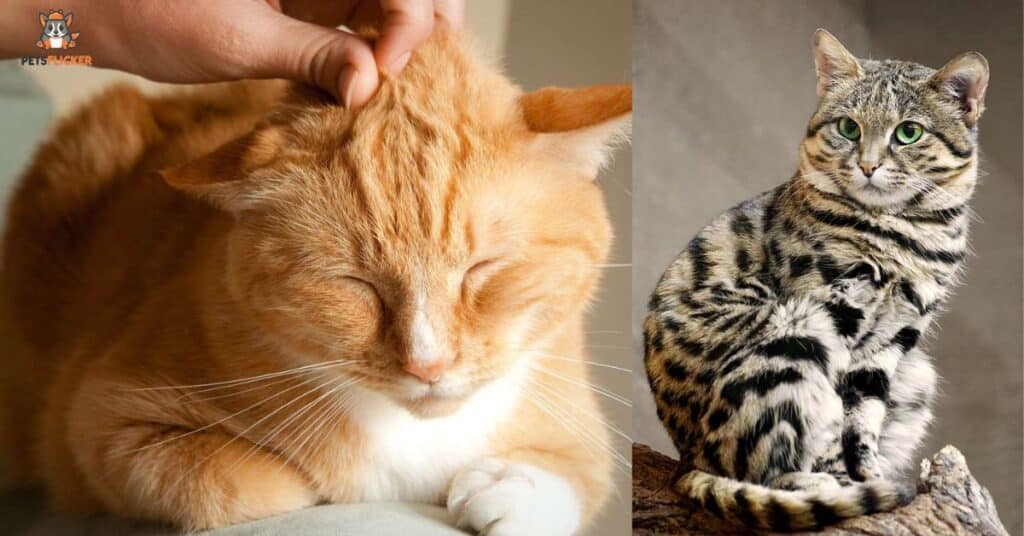Cats’ head sizes can vary due to a range of factors such as breed characteristics, gender differences, and health conditions. For instance, certain breeds like the Munchkin or Devon Rex are known for their small head sizes compared to their body proportions. Male cats typically have larger heads than females, contributing to the perception of smaller heads in some cases.
Neutering can also play a role in altering a cat’s head size. After castration, male cats may develop smaller heads compared to intact males due to the absence of certain hormonal influences. This change in head size is a normal part of the neutering process and doesn’t usually pose any health concerns for the cat.
In some rare cases, a small head in cats may be indicative of underlying health issues such as cerebellar hypoplasia. This condition affects the development of the cerebellum, leading to coordination and mobility challenges. However, it’s essential to consult a veterinarian to determine the exact cause of your cat’s small head and ensure they receive appropriate care if needed.
Cat breeds with small heads

Some cat breeds, like the Munchkin and Devon Rex, are known for their small heads relative to their body size. This unique trait adds to their distinctive appearance and charm.
Read This Article: White Salt Line On Dog’s Nose (Possible Causes)
Munchkin cats
Munchkin cats are renowned for their small legs, but they also possess proportionately small heads, adding to their adorable appearance. This breed’s short stature and compact features make them unique among other feline breeds, appealing to many cat lovers.
Devon Rex
Devon Rex cats are characterized by their curly coats and large ears, but they also have relatively small heads compared to their body size. This breed’s sleek and slender build, combined with their small heads, gives them a distinctive look that sets them apart from other cats.
Cornish Rex
Cornish Rex cats are known for their soft, wavy coats and slender bodies, accompanied by small heads that complement their elegant appearance. Their petite head size adds to their overall gracefulness and agility, making them popular among cat enthusiasts.
Siamese cats
Siamese catsare renowned for their striking blue almond-shaped eyes, short coats with distinctive color points on their ears, face, paws, and tail, and sleek, slender bodies. They are known for their vocal nature, often engaging in conversations with their owners with their loud, expressive voices. Siamese cats are highly social and affectionate, forming strong bonds with their human companions.
Singapura cats
Singapura cats are small in size but big in personality, with large eyes, rounded ears, and short, ticked coats that give them a wild appearance. They are known for their playful and curious nature, often exploring their surroundings with enthusiasm. Despite their small stature, Singapura cats are energetic and agile, enjoying interactive play and attention from their owners.
Persian cats
Persian cats are characterized by their long, luxurious coats, flat faces, and large, expressive eyes. They have a calm and gentle temperament, making them ideal companions for households seeking a relaxed and laid-back feline friend. Persian cats require regular grooming to maintain their coat’s beauty and prevent matting, but their affectionate nature and elegant appearance make them popular pets around the world.
Do male or female cats have smaller heads?

Male and female cats typically have differences in body size and head proportions. In general, male cats tend to have larger heads compared to female cats due to their overall larger body size and weight. This difference is more noticeable during growth stages and can vary among different breeds.
The size disparity between male and female cat heads can be attributed to hormonal influences and genetic factors. Male cats often develop broader skulls and thicker facial features, contributing to their larger head size. It’s essential to note that individual variations exist within each gender, and not all male cats will have significantly larger heads than females.
When observing cat head sizes, it’s crucial to consider breed characteristics as well. Some breeds may have naturally smaller or larger heads regardless of gender. Factors such as neutering, age, and overall health can also influence a cat’s head size and proportions over time.
Also Read This Article: What Happens If A Dog Eats Aquaphor?
Young cats have larger heads than adult cats
Young cats go through significant growth stages where their heads appear relatively larger compared to their bodies. This phenomenon is common in kittens and is a natural part of their development process. As kittens grow, their bodies gradually catch up with their head size, leading to more balanced proportions as they mature.
The larger heads in young cats can be attributed to rapid brain development and skull growth during their early stages of life. This growth spurt is essential for cognitive and sensory development, allowing kittens to learn and adapt to their surroundings. It’s a crucial phase that sets the foundation for their physical and mental well-being as adult cats.
During the kitten hood stage, owners may notice that their pet’s head seems oversized compared to the rest of their body. This disproportionality is normal and indicates healthy growth and development. As kittens continue to grow and reach adulthood, their head-to-body proportions become more harmonious, resulting in a balanced and proportionate appearance.
It’s important for cat owners to provide proper nutrition and care during their cat’s growth stages to support healthy development. Regular veterinary check-ups can also ensure that kittens are meeting their growth milestones and are on track for a healthy transition into adulthood.
Do neutered cats have smaller heads?
Neutering can indeed affect the physical development of cats, including their head size. Male cats that are neutered before reaching puberty may have smaller heads compared to intact males. This is because neutering prevents the development of certain secondary sexual characteristics, such as facial thickenings or shields, which contribute to larger head sizes in intact males.
The absence of specific hormonal influences due to neutering can result in a more slender and streamlined appearance in neutered male cats, including a smaller head size. It’s important to note that the overall health and well-being of a neutered cat are not solely determined by head size but by various factors such as diet, exercise, and veterinary care.
Neutering can lead to smaller heads in male cats, it is a common and recommended procedure for controlling pet populations and preventing unwanted behaviors. Neutered cats often have a longer lifespan and reduced risk of certain health issues, making it a beneficial choice for many pet owners.
The decision to neuter a cat should be made in consultation with a veterinarian, taking into account the cat’s age, breed, and individual health considerations. Veterinary professionals can provide guidance on the best timing for neutering and ensure that the procedure is carried out safely and responsibly.
Obesity
Obesity is a common issue among cats and can have significant effects on their overall health. When a cat becomes obese, it can lead to a disproportionate body shape, with a relatively small head compared to the rest of the body. This occurs because fat accumulates throughout the body, including the neck and face, while the head size remains relatively constant.
Excessive weight can put strain on a cat’s joints, heart, and other organs, leading to various health problems such as diabetes, arthritis, and heart disease. It’s crucial for cat owners to monitor their pet’s weight and ensure they maintain a healthy diet and regular exercise routine to prevent obesity-related issues.
Your cat has cerebellar hypoplasia
Cerebellar hypoplasia is a neurological condition that affects a cat’s cerebellum, leading to coordination and mobility challenges. It is often caused by the feline panleukopenia virus transmitted from the mother cat to her kittens during pregnancy. Kittens with cerebellar hypoplasia may display head tremors and have difficulty walking.
In some cases, cerebellar hypoplasia can result from severe malnutrition in pregnant cats or physical trauma during pregnancy. Kittens infected by toxoplasmosis may exhibit symptoms similar to cerebellar hypoplasia. Despite its challenges, cats with cerebellar hypoplasia do not experience pain due to the condition and can adapt to live relatively normal lives.
The symptoms of cerebellar hypoplasia usually manifest once affected kittens begin standing and walking. They may display a swaying or wobbly gait and have trouble maintaining balance. However, with patience and supportive care from their owners, cats with cerebellar hypoplasia can learn to navigate their environment and lead fulfilling lives.
Cats with cerebellar hypoplasia may require special accommodations, such as soft surfaces or ramps, to help them move around comfortably. Providing a safe and stimulating environment is crucial for these cats to thrive despite their neurological challenges. Regular check-ups with a veterinarian can ensure that they receive appropriate medical attention and support.
Check-in with your cat’s vet
It’s important to schedule regular check-ups with your cat’s veterinarian to ensure their overall health and well-being. Veterinarians can conduct thorough physical examinations and address any concerns or symptoms your cat may be experiencing.
During vet check-ups, your veterinarian can also provide guidance on nutrition, vaccinations, and parasite prevention to keep your cat healthy. They can recommend appropriate diet choices based on your cat’s age, breed, and medical history.
Veterinary check-ups are an opportunity to discuss behavioral issues, such as litter box problems or aggression, and receive advice on how to manage these issues effectively. Your vet can provide behavioral modification strategies and recommend enrichment activities to improve your cat’s quality of life.
Regular dental check-ups are essential for maintaining your cat’s oral health. Dental exams can detect dental issues early, such as tooth decay or gum disease, and your veterinarian can perform professional cleanings to keep your cat’s teeth and gums healthy.
As your cat ages, regular check-ups become even more crucial to monitor for age-related health issues such as arthritis, kidney disease, or thyroid problems. Your veterinarian can perform diagnostic tests and recommend appropriate treatments or management strategies to ensure your senior cat’s comfort and well-being.
Frequently Asked Question
What is cerebellar hypoplasia in cats?
Cerebellar hypoplasia is a neurological condition affecting a cat’s cerebellum, leading to coordination and mobility challenges.
What are some causes of cerebellar hypoplasia in kittens?
Cerebellar hypoplasia can be caused by the feline panleukopenia virus, severe malnutrition in pregnant cats, physical trauma during pregnancy, or infection by toxoplasmosis.
How do cats with cerebellar hypoplasia adapt to their condition?
Cats with cerebellar hypoplasia can adapt to live relatively normal lives despite their coordination challenges.
Why is it important to schedule regular check-ups with your cat’s veterinarian?
Regular veterinary check-ups help ensure your cat’s overall health and well-being, allowing early detection of any potential issues.
What are some topics that can be discussed during vet check-ups?
During vet check-ups, topics such as nutrition, vaccinations, parasite prevention, behavioral issues, and dental health can be discussed.
Why are regular dental check-ups important for cats?
Regular dental check-ups help maintain your cat’s oral health, detect dental issues early, and prevent dental diseases like tooth decay or gum disease.
Conclusion
The size of a cat’s head can be influenced by various factors such as breed characteristics, gender differences, and health conditions like cerebellar hypoplasia. Breeds like the Munchkin, Devon Rex, and Cornish Rex are known for their small heads, adding to their unique charm. Male cats typically have larger heads than females due to their overall larger body size and weight.
Neutering can also affect a cat’s head size, especially if done before puberty, leading to a more slender appearance in neutered male cats. While head size can be an interesting aspect to observe in cats, it’s important to remember that it’s just one of many factors contributing to their overall health and well-being.
Regular veterinary check-ups are crucial for monitoring a cat’s health and addressing any concerns related to head size or other aspects of their physical condition.

Elax is a seasoned writer with five years of experience specializing in articles focused on pets. His passion for animals and extensive knowledge shines through his engaging and informative writing style, captivating readers with insights into pet care and companionship. With a knack for crafting compelling content, Elax brings a wealth of expertise to the realm of pet-centric literature on your website.







